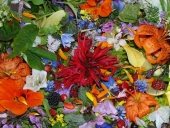John F Dean wrote:I would also have to wonder, "Which road?"
My point being is that I would have less concern regarding a seldom used rural dirt road.
Agreed. location location location. It's the best tool to have. Near the state line, we have many natural forest preserves. The back roads are the least traveled. Thus, road foraging brings in buck loads of blackberries, boysenberries, blue berries, mulberries, various mint, rhubarb, sunflowers, etc. The harvest is very plentiful that several regular sized canning jars will fill up fast.
With this all said, there are issues. Mainly snakes, possums and coons that would pop out and give you a startle. So, wear your muck boots on these endeavors.
Other road gatherings to know about are what a white oak looks like. The leaves are not pointed, but rounded. The acorns have the least tannins. Gathering will fill containers abundantly. One can just store the nuts or process them for storage. Acorn flour is a neat thing to have when everything else isn't available or on hand. Grind the nuts into a flour, spread over a few small trays and place into the food dehydrator. The flour stores for a really long time when all the moisture is removed. Acorns are also great for livestock at a 20-30% mix with outer items for the long winters.
Now, the really sad thing when on the back roads is findings old tires and other junk that people will toss into the country.






.jpg)


